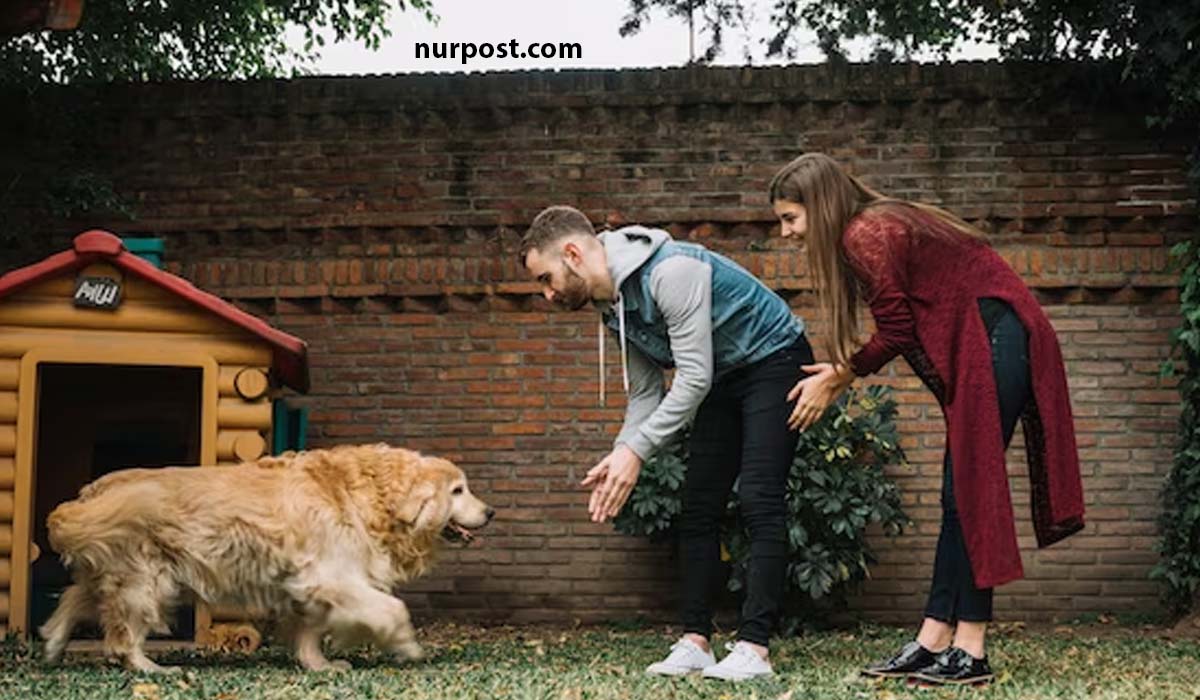Life-Changing Magic of Guide Dogs for the Blind: Your Ultimate Guide. Learn about the incredible bond between visually impaired individuals and their trusted guide dogs, and how these amazing animals are trained to provide life-changing support and independence.
Life-Changing Magic of Guide Dogs
Don’t miss out on this heartwarming and informative read. Trust us, you won’t be able to put it down! Discover the Life-Changing Magic of Guide Dogs for the Blind: Your Ultimate Guide
Discover the Life-Changing Magic of Guide Dogs for the Blind: Your Ultimate Guide. To provide life-changing Discover the Life-Changing Magic of Guide Dogs for the Blind: Your Ultimate Guide
The Life-Changing Impact of Guide Dogs for the Blind
It’s often been said that dogs are a man’s best friend, but for individuals with visual impairments, guide dogs are so much more than just a companion. These highly trained and specialized dogs are the eyes for their visually impaired handlers, allowing them to navigate the world with independence, confidence, and freedom. In this article, we will explore the intricacies of guide dogs for the blind and the incredible impact they have on the lives of their handlers.
What are Guide Dogs for the Blind?
Guide dogs for the blind, also known as “seeing eye dogs,” are specially trained to assist individuals who are blind or visually impaired. They are usually larger breeds, such as Labradors, Golden Retrievers, and German Shepherds, selected for their intelligence, temperament, and calm demeanor.
Life-Changing Magic of Guide Dogs
These dogs undergo extensive and rigorous training to learn how to safely guide their handlers through everyday situations. They are not just trained to follow basic commands, but also to navigate their handlers around obstacles, stop at curbs, and avoid potential hazards. They also learn to disobey commands if they determine that it is not safe for their handler to proceed, making them much more than just an obedient pet.
The Process of Training a Guide Dog
The training of a guide dog starts at a very young age, with puppies typically starting their training at around eight weeks old. The first step is to socialize the puppies, getting them used to different environments, sounds, and people. The puppies are then placed with trained foster families Life-Changing Magic of Guide Dogs, where they receive basic obedience training and exposure to everyday experiences such as riding on public transportation and going to restaurants.
At around 14-18 months of age, the puppies are returned to the guide dog organizations for their formal training. This is where they are matched with their handler, who will have specific requirements and preferences. The training process for the dogs can take anywhere from four to six months, and it involves both classroom instruction and real-world experiences.
The Role of the Handler
The success of a guide dog and their handler’s relationship vastly depends on the handler’s involvement in the training process. Handlers attend classes with their guide dogs to learn how to command and direct them effectively. They are also taught how to properly care for their dogs’ needs, such as grooming and healthcare.
Guide dogs are not just a tool for visually impaired individuals; they also become their loyal and trusted partners, working together as a team to navigate the world. Handlers must build a strong bond of trust and communication with their guide dogs, which takes time and patience. It’s essential for handlers to understand that their guide dogs are not infallible; they can make mistakes and need guidance from their handler.
The Cost of Owning a Guide Dog
The cost of training and providing a guide dog to a visually impaired person is significant. On average, it takes around $50,000 to raise, train, and place a guide dog with a handler. These costs cover breeding, puppy raising, formal training, and ongoing support for the guide dog and their handler Life-Changing Magic of Guide Dogs. However, most guide dog organizations provide their services at no cost to the recipient, relying on donations and fundraising efforts to cover expenses.
The Benefits of Guide Dogs for the Blind
The impact of guide dogs on the lives of their handlers is immeasurable. Not only do these dogs provide their handlers with increased mobility and independence Life-Changing Magic of Guide Dogs, but they also offer companionship and emotional support. Guide dogs help visually impaired individuals overcome various obstacles and challenges, allowing them to feel more confident and empowered.
Studies have also shown that guide dogs positively affect the mental and emotional well-being of their handlers. Many visually impaired individuals report a decrease in anxiety Life-Changing Magic of Guide Dogs, depression, and loneliness after receiving a guide dog. These dogs not only provide physical assistance, but they also offer a constant source of love and companionship.
Getting a Guide Dog
The process of obtaining a guide dog involves multiple steps and can take up to two years. Potential guide dog recipients must go through an extensive application and evaluation process to determine their eligibility and their specific needs. There are also certain qualifications that individuals must meet, such as living an active lifestyle and being able to care for a dog.
Once an individual is approved for a guide dog, they are then matched with a dog that is best suited to their needs and lifestyle. After completion of the training program, the dog is placed with their new handler, and both receive ongoing support and training from the guide dog organization.
Myths and Misconceptions about Guide Dogs
Despite the growing acceptance and use of guide dogs, there are still some myths and misconceptions surrounding these incredible animals. Let’s debunk some of the common myths about guide dogs:
– Myth: Guide dogs are a burden and require constant care from their handlers.
– Reality: Guide dogs are highly trained and independent, requiring minimal assistance from their handlers. Many handlers report that their guide dog’s presence actually reduces the amount of care they need.
Life-Changing Magic of Guide Dogs
– Myth: Guide dogs are aggressive and need to be kept away from other pets and children.
– Reality: Guide dogs are specifically trained to be well-mannered and non-aggressive. They are socialized from a young age, making them friendly and comfortable in various settings.

– Myth: Guide dogs can be used by anyone, regardless of visual impairment.
– Reality: Guide dogs are only trained and provided to individuals with visual impairments. They are not suitable for individuals with other disabilities.
The Impact of Guide Dogs on Society
Guide dogs not only have a significant impact on the lives of their handlers, but they also benefit society as a whole. These dogs increase the mobility and independence of visually impaired individuals Life-Changing Magic of Guide Dogs, allowing them to participate in activities and tasks they may not have been able to do otherwise. Guide dogs also serve as ambassadors, raising awareness and promoting acceptance for individuals with disabilities.
Life-Changing Magic of Guide Dogs
In addition, guide dogs also contribute to the economy, as their handlers are more likely to be employed and lead productive lives. They also save taxpayers’ money by reducing the need for long-term care and assistance for visually impaired individuals.
The Unconditional Love and Dedication of Guide Dogs
It’s clear that guide dogs change the lives of their handlers for the better. Their unwavering loyalty, intelligence, and dedication enable them to become more than just a pet but an invaluable partner to those who need them Life-Changing Magic of Guide Dogs. Guide dogs are living proof that disabilities do not have to limit a person’s abilities and opportunities.
Guide dogs for the blind are exceptional animals that have a tremendous impact on the lives of their handlers and society as a whole. These highly trained and specialized dogs provide their handlers with independence, confidence, and emotional support, allowing them to navigate the world with ease. They are truly life-changing and an excellent example of the human-animal bond.
Life-Changing Magic of Guide Dogs for the Blind
Learn about the incredible bond between visually impaired individuals and their trusted guide dogs, and how these amazing animals are trained to provide life-changing support and independence. Don’t miss out on this heartwarming and informative read. Trust us, you won’t be able to put it down Life-Changing Magic of Guide Dogs! Blind Discover the Life-Changing Magic of Guide Dogs for the Blind: Your Ultimate Guide
Discover the Life-Changing Magic of Guide Dogs for the Blind: Your Ultimate Guide
Guide Dogs for the Blind: Enhancing Independence and Mobility
Guide dogs are more than just furry companions. They are trained to assist individuals with visual impairments and provide them with greater independence and mobility. These intelligent and loyal animals serve as a pair of eyes for their handlers and help them navigate the world around them. In this blog post Life-Changing Magic of Guide Dogs, we will explore the intricacies of guide dogs for the blind, their training process, and the impact they have on the lives of visually impaired individuals.
The Dynamics of Guide Dogs for the Blind
Guide dogs are typically Labrador Retrievers, Golden Retrievers, or a mix of the two breeds. These highly intelligent and well-behaved dogs are chosen for their gentle and friendly nature, making them suitable for the job of being a guide dog. The training process for guide dogs is rigorous and can take up to two years.
During the first year of training, guide dogs are raised by volunteer puppy raisers who expose them to different environments and teach them basic obedience. The dogs also undergo extensive socialization to ensure they are comfortable interacting with people and are not easily distracted by their surroundings.
Life-Changing Magic of Guide Dogs
After the first year, the dogs are placed with professional trainers who teach them more advanced skills such as guiding their handler through crowded streets, navigating obstacles, and avoiding potential dangers. The final stage of training involves matching the guide dog with a visually impaired individual and training them as a team.
The Impact of Guide Dogs on Visually Impaired Individuals
For individuals who are blind or visually impaired, guide dogs provide a sense of independence and freedom that may otherwise be limited. These animals act as a constant companion and provide reassurance and confidence to their handlers. With their keen sense of smell and hearing Life-Changing Magic of Guide Dogs, guide dogs can help their handlers navigate through busy streets, cross roads, and avoid obstacles.
Life-Changing Magic of Guide Dogs
Guide dogs also provide a sense of social inclusion for their handlers. They serve as a conversation starter and can help visually impaired individuals feel more at ease in unfamiliar social situations. Additionally, guide dogs can also help people develop a greater awareness of the needs of individuals with disabilities.
The Training Process: A Closer Look
The training process for guide dogs is complex and thorough, involving both the dogs and their handlers. Let’s take a closer look at some of the essential skills that guide dogs must possess to become successful companions for their handlers.
1. Obedience Training
Obedience training is the foundation of guide dog training. It ensures that guide dogs are well-behaved and responsive to their handler’s commands. The dogs must learn to sit, stay, come when called, and walk calmly on a leash.
2. Socialization
Socialization is a vital aspect of guide dog training as it prepares the dog for different environments and interactions with people and other animals Life-Changing Magic of Guide Dogs. Puppy raisers expose the dogs to a variety of situations, such as riding on public transportation, walking through busy streets, and interacting with different people in different settings.
3. Guiding Skills
Guide dogs are trained to guide their handler in a straight line and to stop at curbs and stairs. They also learn to navigate around obstacles and find specific objects, such as doors and seats Life-Changing Magic of Guide Dogs, to help their handlers navigate through public spaces.
4. Distraction Training
Distraction training is a crucial part of teaching guide dogs to stay focused on their handler regardless of the environment. This training includes exposure to loud noises Life-Changing Magic of Guide Dogs, other animals, and different types of food and treats.
5. Building Trust and Bonding
One of the most critical aspects of guide dog training is building a strong bond between the dog and their handler. Through spending time together, working on tasks, and positive reinforcement, the dog and handler develop a strong connection based on trust and mutual understanding.
6. Team Training
The final stage of guide dog training involves matching the dog with their visually impaired handler and training them as a team. This training includes learning how to communicate with the dog, working on specific routes, and practicing tasks in real-life situations.
The Loyal and Life-Changing Partnership
Guide dogs play a significant role in the lives of visually impaired individuals, providing them with independence, mobility, and companionship. This partnership between dog and handler goes beyond just a working relationship; it is a bond based on trust, love, and mutual dependence Life-Changing Magic of Guide Dogs.
Benefits of Guide Dogs for the Blind
– Enhanced independence and mobility
– Increased confidence and self-esteem
– Greater social inclusion and acceptance
– Improved mental and emotional well-being
– Companionship and unconditional love
– Greater connection and understanding between individuals with and without disabilities
Challenges and Misconceptions
Despite the numerous benefits of guide dogs, there are still some challenges and misconceptions surrounding their use and the individuals who use them. One of the main challenges faced by individuals with guide dogs is access to public spaces.
Life-Changing Magic of Guide Dogs
Some individuals may deny entry to guide dogs due to fear Life-Changing Magic of Guide Dogs Life-Changing Magic of Guide Dogs, allergies, or lack of understanding of their role.

There are also misconceptions about individuals with visual impairments and their abilities to navigate the world with a guide dog. Some people may assume that individuals Life-Changing Magic of Guide Dogs with guide dogs are completely dependent on their animals, which is not the case. Guide dogs are trained to assist their handlers, not do everything for them.
In Conclusion
Guide dogs play an essential role in the lives of individuals with visual impairments. Their rigorous training, tireless dedication, and unconditional love make them invaluable partners to their handlers. These incredible animals not only enhance the independence and mobility of individuals with visual impairments but also promote social inclusion and understanding of people with disabilities.
So Life-Changing Magic of Guide Dogs, the next time you see a guide dog and their handler, remember the incredible bond that exists between them and the positive impact they have on each other’s lives. Discover the Life-Changing Magic of Guide Dogs for the Blind: Your Ultimate Guide
WHAT DO YOU DO WITH BLIND DOGS?
Getting a guide dog for the blind can be life transforming for visually impaired individuals. These specially trained dogs can provide invaluable assistance and companionship Life-Changing Magic of Guide Dogs. However, there are some important things to take into consideration when caring for a blind dog.
ARE GUIDE DOGS FOR THE BLIND ALWAYS ON?
Many people wonder if guide dogs for the blind are always on duty. The answer is no. These guide dogs are trained to work when their harness is on, and to relax and play when it is off. Taking off the harness signals to the dog that it is time to rest and play, just like any other pet dog.
WHAT ARE THE QUALITIES OF A GOOD GUIDE DOG?
Not all dogs are suited to become guide dogs for the blind. Training programs typically look for dogs that are calm, confident, and highly trainable.
Life-Changing Magic of Guide Dogs
They must be able to remain calm and focused in stressful situations, as well as have strong bonds with their handlers. These dogs must also have the desire and ability to perform repetitive tasks. Discover the Life-Changing Magic of Guide Dogs for the Blind: Your Ultimate Guide
